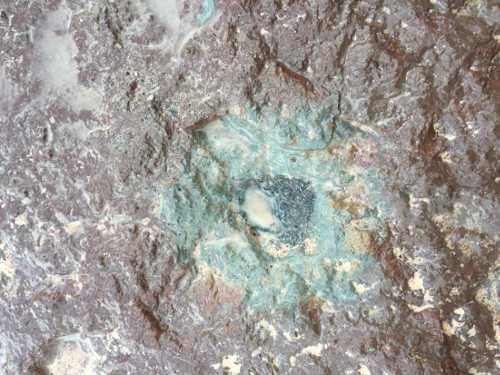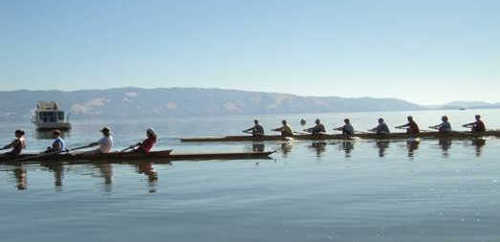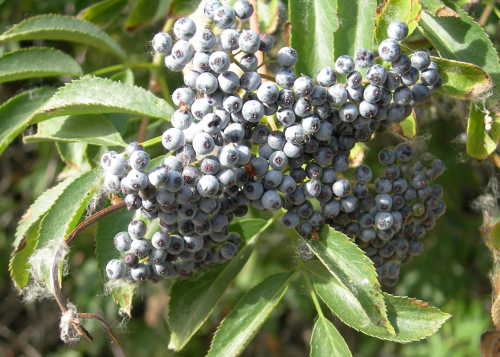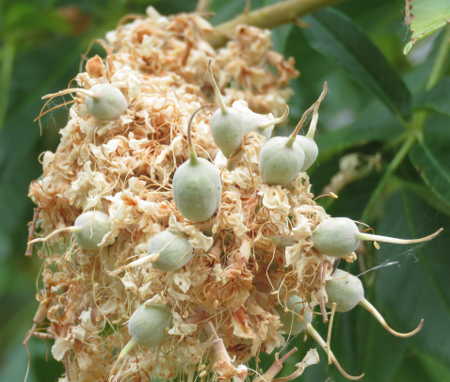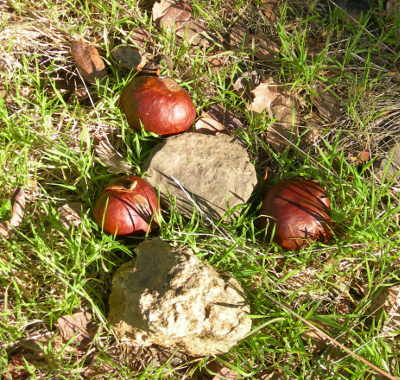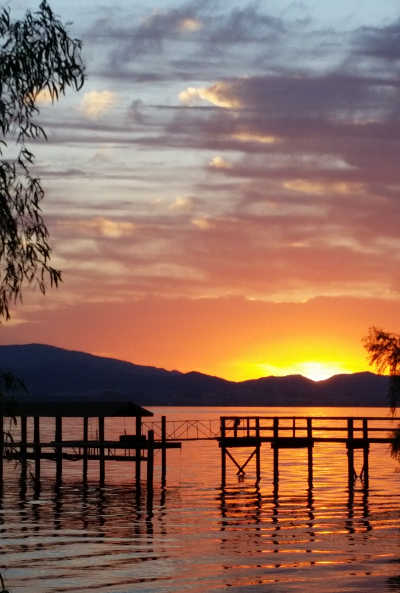
LAKE COUNTY, Calif. – Clear Lake, long a favorite of bass fisherman, has been ranked as the best bass fishing lake in the Western United States and the third-best nationwide in the latest Bassmaster’s 100 Best Bass Lakes rankings.
Clear Lake “continues to produce trophy largemouth, which makes it a premier destination,” Bassmaster Magazine Editor James Hall told Lake County News.
Other California water bodies on the top 10 list included the Sacramento-San Joaquin Delta, ranked No. 5, and Lake Berryessa, No. 7.
Toledo Bend Reservoir, which straddles the Texas and Louisiana border, ranked No. 1 nationwide and is the only lake to earn the title more than once, according to the Bassmaster Magazine ranking.
Based on the list, Texas earned bragging rights for the state with the most ranked lakes, boasting eight fisheries on the list. Florida and California tied for the second most with seven ranked lakes, while New York and Michigan each have six lakes in the Top 100.
There is one big difference in the rankings this year. The Top 10 lakes in the nation are ranked regardless of location, but instead of ranking the remaining lakes through 100, as has been done in the past, Bassmaster reported that it divided the nation into four regions: Northeast, Southeast, Central and Western.
Hall said more than three months of research went into this year’s rankings, which will be published in full in the Bassmaster Magazine July/August issue. It also can be found online at http://www.bassmaster.com/best-bass-lakes .
The majority of the data comes from January through May, but can go back as far as May 2015, Hall said.
“We start off every year by sending out a survey to the fisheries departments for every state in the nation,” Hall said.
Those agencies are simply asked to rank the top 15 to 20 lakes in their region for superior bass fisheries, he said.
The initial pool of top fisheries also is developed with input from B.A.S.S. Nation members across the country, the 3,500-member B.A.S.S. Council and some of the 650,000 Facebook fans of B.A.S.S., the worldwide authority on bass fishing and keeper of the culture of the sport which has been dedicated to access, conservation and youth fishing for more than 45 years.
“After we do those surveys, we kind of squeeze them all together and see what kind of cream rises to the top,” Hall said.
Once they identify all the lakes that should be considered, the supporting research begins. Hall said they scoured the Internet for current catch-rate data, using the results of more than two dozen tournament organizations and several state “lunker” programs to narrow the field to 100.
“It’s a brutal process, but the results give bass anglers the ultimate bucket list of lakes for 2016,” Hall said.
One of the statistics they look at is the average winning weight in fishing tournaments and how deep that goes in the big field events. Hall explained that means not just the winners are catching big fish, but other fishermen further down in the rankings.
Clear Lake has been a standout for the last several years based on the number of really big fish being recorded in those tournaments, he said.
“They're catching fish in the 7- to 10-pound range with incredible frequency,” he said.
“Just the sheer numbers of big fish in that lake make it a dream destination for an angler,” Hall said, adding that anglers who go out to fish on Clear Lake have the opportunity to catch the biggest bass of their lives.
Lakes also are prioritized based on the number of fish caught, Hall said.
Some fisheries this past year have been hit with algae blooms, fish kills or drought, and in the case of some southern lakes, flooding has impacted them particularly hard, according to Hall.
Despite having had its own issues in recent years with drought and algae blooms, Clear Lake nonetheless came out with a top ranking thanks to the list parameters.
“Clear Lake seems to be in a very good spot right now,” Hall said. “The water quality and clarity has been very good.”
The bass population also is thriving and the lake is kept at a very consistent level, which Hall said is always a very good thing for bass recruitment or spawning.
“All of those things are lining up very, very well for Clear Lake right now,” he added.
Aesthetics of the fishery also is important, said Hall.
He said he fished Clear Lake a few years ago, noting the lake's launch ramps are fantastic and the lake is “really easy on the eyes.”
Plus, he said it doesn't hurt to be able to go do some wine tasting to celebrate a good catch.
As for the impact of the rankings on the communities where the top lakes are located, Hall said Toledo Bend – also ranked No. 1 last year – reported a 23-percent increase in tourism.
Other top lake areas reported high visitor numbers. In some cases, he said there were even complaints about too many visitors.
“It evidently really drives a lot of tourism, which is our ultimate goal,” he said.
Hall said the communities that maintain healthy lakes and fisheries should be rewarded for their efforts.
That reward in this case comes through tourism dollars, with Hall noting that fisherman spend a lot of money to pursue their passion.
“I think it's kind of a neat way to give back to the communities,” he said.
The top 10 list of nation's lakes and the lists of regional lakes that were ranked are printed below.
The Top 10 In The Nation
1. Toledo Bend, Texas/Louisiana [185,000 acres]
2. Santee Cooper lakes, Marion and Moultrie, South Carolina [110,000 acres and 60,000 acres, respectively]
3. Clear Lake, California [43,785 acres]
4. Lake Erie, New York [30-mile radius from Buffalo]
5. Sacramento-San Joaquin Delta, California [1,100 square miles]
6. Mille Lacs Lake, Minnesota [132,000 acres]
7. Lake Berryessa, California [20,700 acres]
8. Rodman Reservoir, Florida [13,000 acres]
9. Falcon Lake, Texas [83,654 acres]
10. Lake St. Clair, Michigan [430 square miles]
Central Division
1. Toledo Bend, Texas/Louisiana
2. Mille Lacs Lake, Minnesota
3. Falcon Lake, Texas
4. Sam Rayburn Reservoir, Texas [114,000 acres]
5. Sturgeon Bay, Wisconsin [from Little Sturgeon Bay to Fish Creek]
6. Lake Palestine, Texas [25,560 acres]
7. Caddo Lake, Louisiana [25,400 acres]
8. Grand Lake O’ the Cherokees, Oklahoma [46,500 acres]
9. Lake Ray Roberts, Texas [29,350 acres]
10. Newton Lake, Illinois [1,775 acres]
11. Rainy Lake, Minnesota [360 square miles]
12. Lake of the Ozarks, Missouri [54,000 acres]
13. Green Bay, Wisconsin [up to Little Sturgeon Bay]
14. Lake Fork, Texas [27,690 acres]
15. Lake Minnetonka, Minnesota [14,528 acres]
16. Lake Bistineau, Louisiana [15,500 acres]
17. Minocqua Chain of lakes, Wisconsin [six small lakes up to 3,600 acres]
18. Squaw Creek Reservoir, Texas [3,275 acres]
19. Mississippi River, Pools 4-8, Minnesota/Wisconsin [from Lake City past La Crosse]
20. Lake Hudson, Oklahoma [12,000 acres]
21. Leech Lake, Minnesota [103,000 acres]
22. Lake Dardanelle, Arkansas [40,000 acres]
23. Lake Texoma, Texas/Oklahoma [89,000 acres]
24. Table Rock Lake, Missouri [43,100 acres]
25. Brushy Creek Lake, Iowa [690 acres]
Northeastern Division
1. Lake Erie, New York
2. Lake St. Clair, Michigan
3. Lake Erie, Ohio [30-mile radius from Sandusky]
4. Thousand Islands (St. Lawrence River), New York [50-mile stretch]
5. Saginaw Bay, Michigan [1,143 square miles]
6. Lake Charlevoix, Michigan [17,200 acres]
7. Bays de Noc, Michigan [Escanaba to Little Summer Island]
8. Lake Champlain, New York/Vermont [490 square miles]
9. Grand Traverse Bay, Michigan [32 miles long, 10 miles wide]
10. Presque Isle Bay, Pennsylvania [5.8 square miles]
11. Oneida Lake, New York [79.8 square miles]
12. Cayuga Lake, New York [43,000 acres]
13. Burt/Mullett lakes, Michigan [17,120 acres and 16,630 acres, respectively]
14. Lake Winnipesaukee, New Hampshire [20 miles long, 9 miles wide]
15. Cobbosseecontee Lake, Maine [5,540 acres]
16. Candlewood Lake, Connecticut [5,420 acres]
17. Smith Mountain Lake, Virginia [20,600 acres
18. China Lake, Maine [3,845 acres]
19. Lake Cumberland, Kentucky [65,530 acres]
20. Chautauqua Lake, New York [13,156 acres]
21. Upper Chesapeake Bay, Maryland [The entire bay is more than 64,000 square miles, but the best fishing is in the top one-third.]
22. Pymatuning Reservoir, Pennsylvania/Ohio [17,088 acres]
23. Stonewall Jackson Lake, West Virginia [2,630 acres]
24. Squam Lake, New Hampshire [6,791 acres]
25. Kezar Lake, Maine [2,510 acres]
Southeast Division
1. Santee Cooper lakes, Marion and Moultrie, South Carolina
2. Rodman Reservoir, Florida
3. Chickamauga Lake, Tennessee [36,240 acres]
4. Kentucky/Barkley lakes, Tennessee/Kentucky [160,309 and 58,000, acres respectively]
5. Lake Guntersville, Alabama [70,000 acres]
6. Lake Istokpoga, Florida [26,762 acres]
7. Pickwick Lake, Alabama/Mississippi/Tennessee [43,100 acres]
8. Falls of the Neuse Reservoir (Falls Lake), North Carolina [12,410 acres]
9. Ross Barnett Reservoir, Mississippi [33,000 acres]
10. Lake Murray, South Carolina [50,000 acres]
11. Lake Tohopekaliga, Florida [22,700 acres]
12. Dale Hollow Reservoir, Tennessee/Kentucky [27,700 acres]
13. St. Johns River, Florida [310 miles long]
14. Randleman Lake, North Carolina [3,007 acres]
15. Watauga Lake, Tennessee [6,430 acres]
16. Okatibbee Lake, Mississippi [4,000 acres]
17. Lake Okeechobee, Florida [730 square miles]
18. South Holston Lake, Tennessee/Virginia [7,580 acres]
19. Clarks Hill Lake (Lake Strom Thurmond), Georgia [71,000 acres]
20. Lake Rousseau, Florida [3,700 acres]
21. Lake Eufaula (Walter F. George Reservoir), Alabama/Georgia [46,000 acres]
22. Lake Hartwell, Georgia/South Carolina [56,000 acres]
23. Smith Lake, Alabama [21,000 acres]
24. Lake Seminole, Georgia/Florida [37,500 acres]
25. Lay Lake, Alabama [12,000 acres]
Western Region
1. Clear Lake, California
2. Sacramento-San Joaquin Delta, California
3. Lake Berryessa, California
4. Lake Havasu, Arizona/California [19,300 acres]
5. Dworshak Reservoir, Idaho [17,090 acres]
6. Lake Casitas, California [1,100 acres]
7. Tenmile Lake, Oregon [1,626 acres]
8. Lake Washington, Washington [21,747 acres]
9. Don Pedro Reservoir, California [13,000 acres]
10. Saguaro Lake, Arizona [1,267 acres]
11. Snake River, Idaho/Oregon [100 mile Hells Canyon Wilderness reach]
12. Potholes Reservoir, Washington [14,281 acres]
13. Lake Coeur d’Alene, Idaho [25,000 acres]
14. Roosevelt Lake, Arizona [21,493 acres]
15. C.J. Strike Reservoir, Idaho [7,500 acres]
16. Lake Mohave, Nevada/Arizona [26,500 acres]
17. Banks Lake, Washington [26,886 acres]
18. Columbia River, Oregon/Washington [191 miles from Portland to McNary Dam]
19. Brownlee Reservoir, Idaho/Oregon [15,000 acres]
20. Lake Mead, Nevada/Arizona [158,080 acres]
21. Lake Powell, Utah/Arizona [108,335 acres]
22. Shasta Lake, California [30,000 acres]
23. Flaming Gorge Reservoir, Utah/Wyoming [42,020 acres]
24. Apache Lake, Arizona [2,568 acres]
25. Sand Hollow Reservoir, Utah [1,300 acres]
Email Elizabeth Larson at This email address is being protected from spambots. You need JavaScript enabled to view it. . Follow her on Twitter, @ERLarson, or Lake County News, @LakeCoNews.




